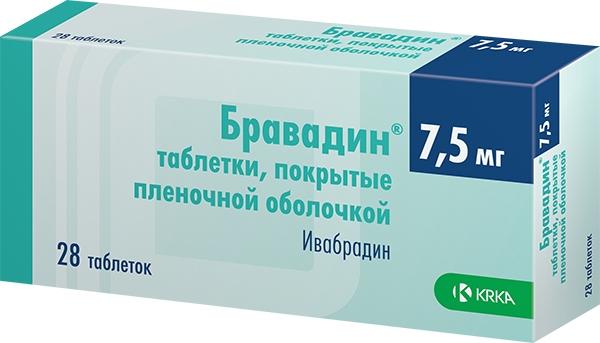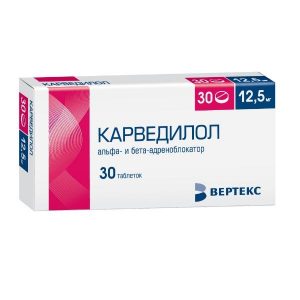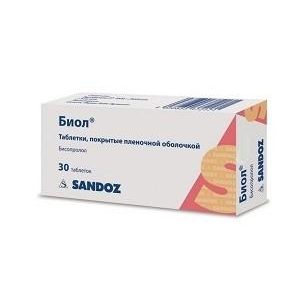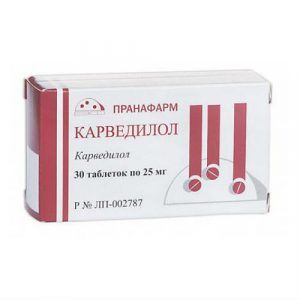Description
Release form
Film-coated tablets.
Packing
28 pcs.
Indications
1. Stable angina pectoris.
Therapy of stable angina pectoris in adult patients with normal sinus rhythm: – in case of intolerance or contraindications for the use of
beta-blockers – in combination with beta-blockers with inadequate control of stable angina pectoris against the background of an optimal dose of beta-blocker.
2. Chronic heart failure.
To reduce the incidence of cardiovascular complications (mortality from cardiovascular disease and hospitalization due to increased symptoms of chronic heart failure (CHF)) in patients with heart failure, with sinus rhythm and heart rate of at least 70 beats / min.
Contraindications
– Hypersensitivity to irbesartan, amlodipine and other derivatives of dihydropyridine, as well as to arterial hypotension, CHF IV functional class according to NYHA classification, simultaneous use with “slow” calcium channel blockers (BMCC), reducing heart rate (verapamil or diltiazem), simultaneous use with non-potassium-sparing diuretics.
Use during pregnancy and lactation
Pregnancy.
Animal studies have demonstrated the presence of reproductive toxicity, embryotoxicity and teratogenicity.
The drug Bravadin is contraindicated for use during pregnancy due to insufficient safety data.
Breastfeeding period.
The use of the drug Bravadin during breastfeeding is contraindicated. It is not known whether ivabradine passes into breast milk.
If you need to use the drug Bravadin during lactation, breastfeeding should be discontinued.
Composition
1 tab.: – ivabradine hydrobromide, respectively. the content of ivabradine 7.5 mg.
Dosage and administration
Inside, twice a day (morning and evening) during meals.
1. Stable angina pectoris: The recommended starting dose is 10 mg per day (1 tablet 5 mg twice a day).
After 3-4 weeks of therapy, the dose can be increased to 15 mg per day (1 tablet 7.5 mg twice a day) depending on the therapeutic effect.
If during the use of the drug Bravadin heart rate at rest is less than 50 beats / min, or the patient has symptoms associated with bradycardia (dizziness, increased fatigue, or a marked decrease in blood pressure), the dose of the drug Bravadin should be reduced to 2.5 mg (1 / 2 tablets 5 mg) twice a day.
Bravadin therapy should be discontinued, if with a decrease in the dose of the drug Bravadin, heart rate remains less than 50 beats / min or the symptoms of severe bradycardia persist.
2. Chronic heart failure: The recommended starting dose is 10 mg per day (1 tablet 5 mg twice a day).
After 2 weeks of therapy, the dose can be increased to 15 mg per day (1 tablet 7.5 mg twice a day), if heart rate alone is stable over 60 beats / min, or reduced to 2.5 mg (1 / 2 tablets 5 mg) twice a day, if the heart rate is stable less than 50 beats / min or the patient develops symptoms associated with bradycardia (dizziness, increased fatigue, or a marked decrease in blood pressure). If the heart rate is in the range of 50-60 beats / min, it is recommended to use the drug Bravadin in a dose of 5 mg twice a day.
If during use of the drug Bravadin heart rate at rest is less than 50 beats / min or the patient has symptoms associated with bradycardia, for patients receiving the drug Bravadin in a dose of 5 mg twice a day or 7.5 mg twice a day , the dose of the drug should be reduced.
If in patients receiving the drug Bravadin at a dose of 2.5 mg (1/2 tablet 5 mg) twice a day or 5 mg twice a day, heart rate alone is stable over 60 beats / min, the dose of the drug Bravadin may to be increased.
If heart rate remains below 50 beats / min or the patient has symptoms associated with bradycardia, Bravadin therapy should be discontinued.
Patients older than 75 years: For patients 75 years of age and older, treatment should be started with a lower dose. The recommended starting dose is 2, 5 mg (1/2 tablet of 5 mg) twice a day. In the future, the dose may be increased.
Impaired renal function: Patients with impaired renal function (CC more than 15 ml / min) do not require dose adjustment.
Recommended starting dose is 10 mg per day (1 tablet 5 mg twice a day). After 3-4 weeks of therapy, the dose can be increased to 15 mg per day (1 tablet 7.5 mg twice a day).
Due to insufficient clinical data, Bravadin should be used with caution in patients with CC less than 15 ml / min.
Impaired liver function: Dose adjustment is not required in patients with mild liver failure (up to 7 Child-Pugh scores). Caution should be exercised when using the drug Bravadin in patients with moderate hepatic insufficiency (7-9 points on the Child-Pugh scale).
In patients with severe hepatic insufficiency (more than 9 points on the Child-Pugh scale), the use of the drug Bravadin is contraindicated.
Children and adolescents: The safety and effectiveness of ivabradine in children and adolescents under the age of 18 have not been established.
Drug Interaction
Pharmacodynamic Interaction: Concomitant use is not recommended: QT-prolonged drugs: – Antiarrhythmic agents that prolong QT intervals (e.g., quinidine, disopyramide, bepridil, sotolol, ibutyl, ibutyl, ibuti) QT prolongers not related to antiarrhythmic agents (eg, pimozide, ziprasidone, sertindole, mefloquine, halofantrine, pentamidine, cisapride, erythromycin for intravenous administration). The concomitant use of ivabradine and PM, which prolongs the QT interval, is not recommended, as reducing the heart rate may cause an additional extension of the QT interval. When concomitant administration is required, careful monitoring of the ECG is required.
Concomitant use with caution: – Non-potassium diuretics (thiazide and “loop”)
Hypokalemia may increase the risk of arrhythmia. Because ivabradine can cause bradycardia, the combination of hypokalemia and bradycardia is a predisposing factor for the development of severe arrhythmia, especially in patients with QT prolonged syndrome, as congenital, and caused by the use of drugs.
Pharmacokinetic interaction: Cytochrome P450 ZA4 (CYP3A4 isoenzyme)
Ivabradine undergoes hepatic metabolism with only CYP3A4 isoenzyme and is a very weak inhibitor of this cytochrome. Does not affect the metabolism and concentration in the blood plasma of other substrates (strong, moderate and weak inhibitors) of the CYP3A4 isoenzyme. CYP3A4 isoenzyme inhibitors and inducers may interact with ivabradine and have clinically relevant effects on its metabolism and pharmacokinetic properties. CYP3A4 isoenzyme inhibitors increase, and CYP3A4 isoenzyme inducers reduce the plasma concentration of ivabradine. Increasing the concentration of ivabradine in the blood plasma may cause the risk of severe bradycardia (see section “Special instructions”).
Concomitant use is contraindicated: Concurrent use with strong CYP3A4 isoenzyme inhibitors such as antifungal agents azole (ketoconazole, itraconazole), macrolide antibiotics (clarithromycin, erythromycin for intramuscin intake) ) and nefazodone is contraindicated (see Contraindications). Strong CYP3A4 isoenzyme inhibitors – ketoconazole (200 mg once daily) or mozamycin (1 g twice daily) increase the average plasma concentration of ivabradine 7-8 times.
Overdose
Symptoms: An overdose of Bravadine can lead to severe and prolonged bradycardia.
Treatment: Treatment of severe bradycardia is symptomatic and should be performed in a specialist hospital setting. In case of combination of bradycardia with violation of hemodynamic parameters, the use of beta-adrenomimetics (isoprenaline) is required. If necessary, install an artificial rhythm driver.
Terms leave from
pharmacies by prescription
lekarstvennaja tablet form
Prescribing
For adults as prescribed by a doctor
Indications
Indications
Cardiac insufficiency, Angina, Arrhythmia, Chronic circulatory failure
KRKA d.d. Novo mesto AO, Slovenia




